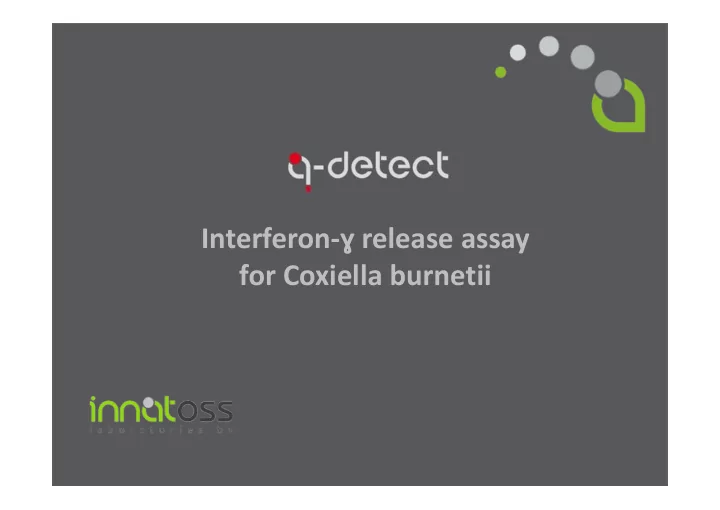

Interferon- ɣ release assay for Coxiella burnetii
Q fever Caused by bacteria Coxiella burnetii Human infections after shedding by animals (goats, sheep, cattle, etc.) Found worldwide except New Zealand Main type of diagnostics: serology Main treatment: antibiotics (doxycycline) Largest outbreak : The Netherlands in 2007-2010: 100,000 infections by goats Vaccination programs: in Australia 2
What ’ s new? First diagnostic test based on cellular immune response In vitro blood stimulation with killed off Coxiella bacteria* Interferon- ɣ production used as response measure * Schoffelen et al., 2013 3
Q-detect looks at T-cell response Humoral immunity B-cells Serology IgG - IgM 4
Q-detect looks at T-cell response Humoral immunity Cellular immunity + B-cells T-cells Q-detect Serology Interferon ɣ IgG - IgM 5
Q-detect way of working Blood withdrawal (8 ml) Stimulation with killed bacteria in biosafety level 2 laboratory 6
Q-detect way of working 24 h incubation @37 ⁰ C Washing and colouring (ELISA) Interferon- ɣ measurement 7
Q-detect results Results based on individual: • Coxiella induced IFN- γ production (cox - neg) • Relative Coxiella Response vs. PHA Large study* in high prevalence community compares IFA** to Q-detect ( > 5 years after infection ) 1000 Q-detect finds 80% more Q fever infected people 900 800 700 +68% 600 500 400 300 IFA 200 100 Q-detect 0 Q fever positive * Q-Herpen II Study, 2014, >1,500 people included, financed by the Dutch Ministery of Health, Welfare and Sports 8 ** Focus Diagnostics
Product information Validated on > 1,600 volunteers Sensitivity: 94% (at prevalence of 10%) Specificity: > 92% CE marked (Dec 2014) Can be adapted for veterinary use Q-detect in combination with IL-2 investigated for QFS 9
Innatoss Laboratories Molenstraat 110, 5342 CC Oss, the Netherlands (Pivot Park, Room RE 2428) Contact: Maarten van der Zanden E: maarten.vanderzanden@innatoss.com T: +31 637353787 10
Recommend
More recommend